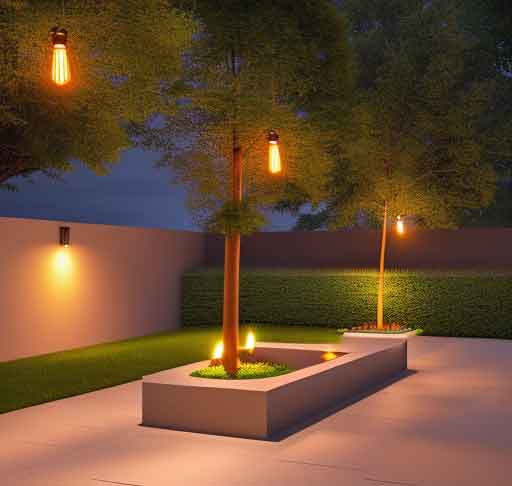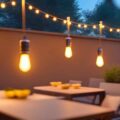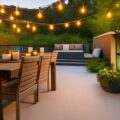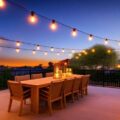Last Updated:April 07, 2024
What’s the Difference Between Filament Light Bulbs and Edison Light Bulbs for Outdoor Lighting?

Understanding the Difference: Filament Bulbs, Vintage Edison Light Bulbs and LED Bulbs
When it comes to outdoor lighting solutions, there are a plethora of choices available in the market, yet the prime ones that dominate this arena are the filament bulbs, Edison light bulbs and LED bulbs. This write-up aims to elucidate the difference between these bulb types and shed light on their pros and cons to help you make an informed choice. It’s noteworthy to mention that with a wide array of lighting options offered, you may feel overwhelmed, but understanding these essentials can ease your selection process.
Let’s begin with filament light bulbs, often celebrated as the precursor to modern lighting solutions. They’re an evocative of days gone by, particularly adored by antique enthusiasts. Their unique charm shines through their distinct amber glow, casting a warm and cozy atmosphere in the surroundings. However, despite their aesthetic appeal, filament bulbs, being incandescent bulbs, consume more power and thus, aren’t as energy efficient as their modern counterparts, the LED bulbs.
On the other hand, vintage Edison light bulbs are nothing but incandescent bulbs with a twist; named after the renowned inventor, Thomas Edison, these bulbs carry a distinctive nostalgic aura. Edison bulbs, like standard filament bulbs, come with a certain charm, but they offer better longevity compared to regular filament light bulbs, thereby repaying the slightly higher up-front costs with longer usage. Nevertheless, similar to filament bulbs, Edison bulbs also fall short when concerned with energy efficiency.
An interesting variation to look for is indeed the LED filament bulbs. On the outside, these mimic the aesthetic appeal of an antique bulb, but on the inside, they’ve got all the modern tech of LED bulbs. These not only look like an old-school filament bulb but also offer the energy efficiency of LEDs, hence providing a perfect balance of vintage charm and modern sensibility.
Furthermore, LED bulbs outrightly ace the race with their superior energy-efficiency and longer lifespan. Today, LED bulbs have emerged as standard choices for outdoor as well as indoor applications, mainly because of the immense energy savings they offer along with their environmental friendliness. Upfront, LED light bulbs might appear as an expensive affair, but they prove their worth in the long run with significant reduction in electricity bills and infrequent need for replacement.
In conclusion, choosing between vintage filament bulbs, Edison bulbs, and LED bulbs fundamentally boils down to your needs and preferences, whether you are favorable towards a warm, nostalgic glow or more concerned with efficiency and sustainability. In this age of lighting revolution, LED-pioneered, you always have the versatility in your hands to opt for a LED bulb Edison style or opt for the revolutionary and standard LED versions that pack a punch in efficiency.
We’ve written a complete guide to bistro lighting if you’re looking for more broad information.
Crucial Points in Edisons’s Light and LED Filament Bulb’s Deconstruction
The differences between Edison’s light and LED filament bulb are indeed worth exploring, as is the variation of these bulbs in an outdoor lighting scenario. Edison light bulbs, often referred to as Edison bulbs or vintage bulbs due to their rustic allure, champion the traditional incandescent lighting technique. Infused with Edison’s personality, coupled with the intricate craftsmanship of its filament, these bulbs produce a warm, inviting glow that invites nostalgia. Edison bulbs, be it of the regular or bulb Edison type, bring a sense of style to any lighting setup.
In stark contrast are LED bulbs. Equipped with a LED filament, they are the modern counterpart to Edison bulbs. LED bulbs consume less energy, thus making them a cost-effective choice in the long run. This attribute of LED bulbs, along with the bright, crisp light it produces, has made them a popular choice in both residential and commercial lighting. This is in spite of the initial investment that is often higher than that of incandescent bulbs.”
Vintage Edison light bulbs, with their filament coils visible, often bring a certain character to a space. Yet this aesthetic vintage appeal means they are often used in places where their light is a design feature, rather than the primary source of light.
The LED filament bulb has been engineered to mimic the appearance of a filament bulb, maintaining much of the vintage charm of Edison bulbs, while benefitting from the economy and efficiency of LEDs. While the LED filaments provide an advantage in terms of a power saving feature, the style of light emitted can be much harsher and more directional than the soft glow from an Edison filament.
Now for incandescent lighting. Incandescent bulb technology is incredibly similar to that of the Edison light bulb, utilizing a tungsten filament that glows when heated. However, where Edison bulbs often have a design edge, generic incandescent bulbs are more likely to be hidden within light fixtures. Much like the bulb Edison and other Edison bulbs, they create a warm, welcoming light, yet fall short in energy efficiency compared to LED bulbs.
So, what is the fundamental difference between these types of light bulbs for lighting, particularly outdoor lighting? It’s a matter of personal preference and application. Deciding between the romantic feel of Edison’s filament bulbs and the sleek efficiency of LED bulbs is often a balance of aesthetic and economic considerations, refined by the specifics of your lighting needs.
The LED light bulb, filament bulbs, and vintage Edison light bulbs all provide unique lighting solutions with distinct advantages and disadvantages. Understanding these crucial points in the ‘deconstruction’ of these types of lighting can guide you in selecting the right bulb for your outdoor lighting needs. Remember, in the world of light bulbs, one size or type certainly does not fit all!

The Antique Charm in Vintage Filament: Filaments of Truth Revealed
It’s clear that the antique charm in vintage filament and LED bulbs has sparked interest in what brought about these intriguing creations. The filaments that run through vintage-style bulbs in the past differed in several aspects to today’s energy-efficient LED bulbs. They were often encased in clear glass, which emphasized the beauty of the large glowing filaments within. In contrast, LED bulbs use small diodes to emit light, thereby saving energy.
The difference between filament light bulbs and Edison light bulbs, especially for outdoor lighting, revolves largely around their aesthetics and energy usage. The filament bulbs, particularly those with a vintage design, have a certain aesthetic appeal—suitable for areas where a warm ambiance is sought. Filament bulbs give off a nostalgic reservoir of light reminiscent of earlier times when Thomas Edison introduced the light bulb to the world.
The large glowing filaments in vintage filament bulbs, conspicuous through their clear glass enclosures, are a sight to behold. However, their energy consumption is much higher compared to LED bulbs, with a vintage expressions that share a semblance in design. In other words, an LED bulb with a vintage design can offer the distinct design of filament bulbs but with reduced energy consumption. In the comparison of filament bulbs and LED bulbs, the latter stands out as the environmentally friendly choice.
With their antique charm, vintage filament bulbs, especially those patterned after Edison’s original design, continue to be in demand. These bulbs, having a filament and encased in clear glass, bring old-world elegance to any environment. They draw attention to themselves, making a clear statement of style. However, with growing concern for the environment, LED bulbs have become the favoured choice, especially for outdoor lighting.
LED bulbs, to some extent, have managed to emulate the vintage appeal of filament bulbs, mainly through clear glass enclosures that show their luminous filaments. However, they do this all while maintaining a low energy footprint. Thus, it can be said that a vintage LED bulb is the hybrid of an Edison bulb with its antique vibes and an environment-friendly LED bulb.
So, if you’re torn between choosing the antique charm of vintage filament bulbs showing the large glowing filaments through clear glass enclosures, or energy-efficient LED bulbs with a vintage design, why not opt for LED bulbs with vintage design elements? By doing this, you are paying homage to the vintage ambiance of filament bulbs but in a more sustainable and practical way.
In conclusion, while the difference between filament light bulbs and Edison light bulbs might seem technical, understanding their functionalities and unique aesthetic qualities allows for an informed choice. Filament bulbs are perfect for those who love the unmistakable rustic vintage appeal, but for those who value sustainability and efficiency, LED bulbs are the obvious choice.
LED Bulbs Vs Incandescent Bulbs: Battle of the Light Bulb Types
When we delve into the world of lighting, the conversation often revolves around two key types of light bulbs – the vibrant LED bulbs, and the classic incandescent bulbs. These light bulb types have lit up homes and spaces for years, and understanding their distinct differences is vital.
Incandescent bulbs, otherwise known as the Edison Bulb or the incandescent lamp, have been around the longest, paying homage to Thomas Edison’s historical invention. These bulbs emit their characteristic warm, inviting light by passing an electric current through a wire filament which glows as it heats up. Many homeowners favor for these light bulbs because of their timeless, vintage appeal, perfectly capturing an antique charm in outdoor and indoor lighting alike. However, the light from incandescent bulbs isn’t as bright as their modern counterparts, which is where LED bulbs enter the scene.
The introduction of LED bulbs marked a significant shift in the world of lighting. LED, which stands for Light Emitting Diode, has become the shining star of modern lighting. These bulbs produce light by passing electric currents through a semiconductor, making them incredibly energy-efficient compared to incandescent lamps. Looking at an LED bulb, you’ll find they’re brighter and more potent than any incandescent bulb, making them ideal for task lighting or security purposes, especially in LED bulbs for outdoor lighting.
When you compare LED bulbs with incandescent bulbs, you’ll find numerous differences. In terms of efficiency and longevity, LED is a clear winner. However, for subtle, warm, and welcoming light, many homeowners still prefer incandescent bulbs. But having said that, advancements in LED bulb technology have led to the creation of vintage filament LED bulbs; an amalgamation of the modern efficiency of LED lighting and the charming warmth of a filament bulb.
This fusion is where the true battle of the light bulb types occurs. Vintage filament LEDs appear very similar to Edison bulbs, mimicking their warm, soft glow. They’re perfect additions to spaces where the aesthetic appeal of incandescent bulbs is desired, alongside LED efficiency. These light bulbs take the best of both worlds – amalgamating the antique charm of a vintage filament with the modern efficiencies of LED bulbs.
In conclusion, the comparison between LED bulbs and incandescent bulbs depends on the desired effect and efficiency. The old world charm of Edison bulbs can indeed create atmosphere and nostalgia. In contrast, the brightness and energy-efficiency of LED bulbs are unparalleled. Time will tell who wins this battle of the light bulb types, but one thing is certain – whether it’s the incandescent or LED bulb you prefer, one of them will continue to light up our lives.
The Final Verdict: Is LED or Edison Light Bulb Better in the Realm of Outdoor Lighting?
The final verdict is here, and it’s time to ask: Which is superior for outdoor lighting – LED or Edison light bulbs? This query has been a pivotal focus when it comes to lighting in outdoor spaces. Issues concerning light bulbs, indeed, go beyond bulb types such as vintage filament and Edison bulbs. Nonetheless, the rivalry appears to boil down to two key players- LED and Edison bulbs.
LED bulbs are fast becoming a beacon in the realm of outdoor lighting. These light-emitting diodes offer exceptional performance that sets them apart. Notwithstanding, the allure of the vintage Edison light bulb remains undeniable, offering charm and a nostalgic ambiance that enhances outdoor spaces uniquely – especially when you consider the antiquity associated with vintage filament light bulbs.
When discussing Edison’s light bulbs, the conversation often revolves around their design. The filament design is indeed a distinguishing factor. However, that isn’t all Edison bulbs bring to the table for outdoor lighting; they are renowned for their warm, inviting glow that sets a calming mood. Regardless, considering the energy efficiency of LED bulbs, notably in comparison with incandescent bulbs, they undeniably rule in the long haul, especially in terms of cost-effectiveness.
A LED bulb has a powerful lumen capacity, exuding excellent amount of brightness for outdoor or exterior spaces. Lighting subsequently becomes enhanced, improving safety and functionality. Moreover, LED bulbs, which come in various color temperatures, offer an array of lighting effects that cater to distinct tastes. Hence, LEDs’ versatility underscores their dominance among other light bulb types.
While a vintage Edison light bulb might offer aesthetic appeal, it’s undeniable that a LED bulb is superior in terms of longevity, energy efficiency, and light output. Realistically, LED lighting has the upper hand for outdoor applications; it’s as cut and dried as that. This undeniable reality doesn’t necessarily dilute the intrigue that Edison bulbs pose, rekindling reminiscences of an era where vintage format lighting was the rave.
With multiple LED units within a single bulb, represented in a spectrum of colors, LED bulbs indeed reincarnate vintage style in a modern way. Consequently, you aren’t essentially forgoing the vintage charm of an Edison bulb by choosing an LED. The final verdict, thus, is clear: LED bulbs have the edge for outdoor lighting.
In conclusion, the comparison of Edison versus LED bulbs for outdoor lighting might be wrought with emotion, particularly as they echo the emergence of modern technology while paying tribute to the vintage charm. Nevertheless, in terms of outdoor application, LED bulbs reign supreme over Edison bulbs. They bring innovation, sustainability, and unmatched performance to the table, consequently dethroning Edison bulbs from their historic pedestal. After all, in the realm of outdoor lighting, it’s practicality, not so much nostalgia, that wins the day.
Regardless of your choice, make sure that the bulbs are rated for outdoor use and are protected from direct exposure to water to ensure their safety and longevity. With the right light bulbs, you can transform your outdoor space into a beautiful and welcoming oasis that you and your guests will enjoy. If you’d like to learn more about outdoor lighting, we’ve written a full guide on that topic.



